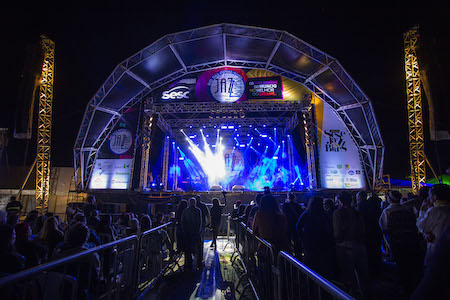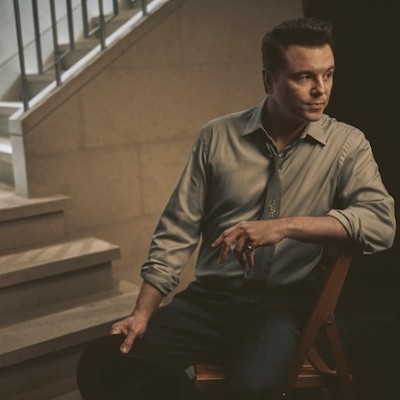Dec 9, 2025 12:28 PM
In Memoriam: Gordon Goodwin, 1954–2025
Gordon Goodwin, an award-winning saxophonist, pianist, bandleader, composer and arranger, died Dec. 8 in Los Angeles.…

One of three beachside stages at the Rio das Ostras Jazz & Blues Festival.
(Photo: Cezar Fernandez)For those seeking a truly unique jazz and blues getaway, perhaps a trip to Brazil is in order during late May into early June.
Celebrating its 20th annniversary, the Rios das Ostras Jazz and Blues Festival is planning a special blowout May 30–June 2 with more than 30 acts performing over the four days.
Located just over 100 miles from Rio de Janeiro, Rio das Ostras touts high-powered music from the beautiful setting of beaches and lagoons that the city has to offer.
DownBeat caught up with the festival’s founder and producer, Stênio Mattos, to discuss the anniversary edition and what makes this festival so special.
Frank Alkyer: How did the festival get started, and why did you focus on jazz and blues?
Stênio Mattos: I arrived in Rio das Ostras in 2002, invited by the secretary of tourism, Gilberto Menezes, an old friend. He wanted a different project for the city, to change from shows like axé music, lambada, sertanejo, Brazilian funk, etc. My idea was to build a new audience to attract more tourists. So, I created the project Rio das Ostras Instrumental, a series of free shows on the beautiful Costazul beach at dusk, with prominent Brazilian instrumental music artists. From 2001 to 2004, we had more than 50 artists participating.
We wanted to be sure we were on the right path to do something bigger, a jazz and blues festival. So, in 2003, we showed the Rio das Ostras Jazz & Blues Festival project to the mayor of the city. It was not an easy task. No sponsors — we could only count on money from city hall. Anyway, we managed to convince them, but if it didn’t work out, the secretary and I would be fired. [laughs]
In the first festival, we had difficulties like every first event, but we had the help of international and national musicians such as Stanley Jordan, Naná Vasconcelos, Yamandú Costa, Norton Buffalo and Jane Monheit, among others. They were fantastic. They did everything they could to make it happen.
Today it is considered by the specialized media to be the largest of its kind in Brazil and Latin America. We went from an audience of 5,000 people in 2003 to 120,000 in 2023, being part of the official events calendar of the State of Rio de Janeiro (through state law) since September 2011.
Alkyer: For our readers who have no idea what Rios Das Ostras is like, can you tell us about your town and your area?
Mattos: The city, 170 kilometers from Rio de Janeiro, stands out for its tourism and exuberant nature. On its 28 kilometers of coastline there are 15 beaches with clean and calm waters that are attractive for their preservation and infrastructure. The sun shines at least 300 days a year. The city also offers an Eco Rural Circuit that brings together countryside, mountains and lakes and also has a good hotel network, with around 70 hotels and inns and more than 50 bars and restaurants.
In addition, Rio das Ostras is known for its cultural aspect, being declared by state law as “the jazz and blues capital of the State of Rio de Janeiro” in 2011 due to [the festival’s] success.
Alkyer: What is the festival site like? Where are the stages? How many visitors attend each year?
Mattos: We have three stages spread across the city’s beaches with about 2 kilometers between them. The shows start at 11 a.m. and end at 2 a.m. Over the four days of the festival, we have an estimated audience of 100,000 people.
Alkyer: For those looking to take in all that Rio das Ostras has to offer, what are some of the favorite sites and, of course, what is the nightlife like?
Mattos: The city’s favorite places are the beaches.The main beaches are Costazul beach, frequented by surfing and bodyboarding groups. It becomes a hotspot at dusk with many options for restaurants, bars and kiosks. Boca da Barra beach is a natural outdoor pool with lots of tranquility. Praia da Virgem is a totally preserved place that fills the eyes of naturalists with pride, a peaceful, preserved place full of life.
The city offers numerous other tourist attractions. The highlight is the Rocky Coasts Natural Monument, an ecological reserve strip, rich in fauna and flora. The Sambaqui da Tairoba museum is a national heritage site opened in 2015 and has a historical collection of bones from the community that lived here 3,500 years ago. In addition to these attractions, Rio das Ostras offers opportunities for ecotourism, with ecological trails and dozens of rural properties that welcome tourists and promote new economic activity, highlighting the culinary flavors of the sites and farms.
Alkyer: What is your concept for booking the festival?
Mattos: The first step is to be careful and prioritize the quality of the musicians. The second step is to talk to the musician and show that the festival was created with the aim of forming an audience, bringing quality music to everyone at no cost, and that they will play outdoors on a sunny beach. For example, one of the stages is set up on a big rock formation, turtles swimming next to them, with a vibrant audience of 25,000 people.
The last factor is the question of value. We have limitations; there’s no ticket fees or big sponsors.
Alkyer: What are you looking forward to this year?
Mattos: We are especially excited about the bassists, who range from the well-known Richard Bona to newcomers such as Kinga Glyk, and Mohini Dey, playing with the Romero Lubambo All Stars.
Of course, names that return for the 20th edition such as Spyro Gyra and James Carter Organ Trio are always special, as is the traditional group of Brazilian artists formed by guitarist and mandolinist Armandinho Macedo and accordionist Chico Chagas, mixing different rhythms of Brazilian popular music.
Not even in my wildest dreams could I have imagined to reach this milestone. When you work with public authorities, you are dependent on the will of the next government official to continue the festival or not. Then, I just hope for a lot of joy, music and total integration between the audience, musicians and everyone that contributed to getting us here, especially the city of Rio das Ostras, which believed in this dream incorporating the festival with pride. It moves me to walk through the streets of the city in the period leading up to the festival. You see people anxious, waiting; everyone is already working in some way for the success of the event, feeling proud of their city. Come on, we wait for you at the party. DB

Goodwin was one of the most acclaimed, successful and influential jazz musicians of his generation.
Dec 9, 2025 12:28 PM
Gordon Goodwin, an award-winning saxophonist, pianist, bandleader, composer and arranger, died Dec. 8 in Los Angeles.…

Flea has returned to his first instrument — the trumpet — and assembled a dream band of jazz musicians to record a new album.
Dec 2, 2025 2:01 AM
After a nearly five-decade career as one of his generation’s defining rock bassists, Flea has returned to his first…

“It’s a pleasure and an honor to interpret the music of Oscar Peterson in his native city,” said Jim Doxas in regard to celebrating the Canadian legend. “He traveled the world, but never forgot Montreal.”
Nov 18, 2025 12:16 PM
In the pantheon of jazz luminaries, few shine as brightly, or swing as hard, as Oscar Peterson. A century ago, a…

Dec 11, 2025 11:00 AM
DownBeat presents a complete list of the 4-, 4½- and 5-star albums from 2025 in one convenient package. It’s a great…

Seth MacFarlane takes a turn from his television and film career to sing arrangements made for Frank Sinatra, but never recorded.
Nov 18, 2025 12:04 PM
“I’m not gonna lie to you — I don’t know why I thought this was about The Naked Gun, but I’m happy it’s…